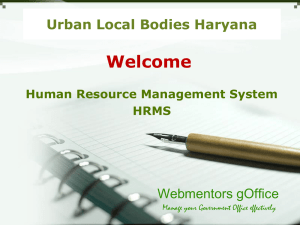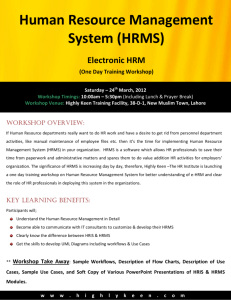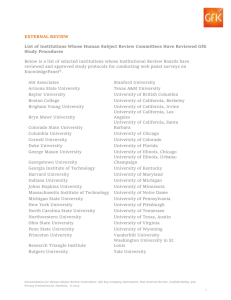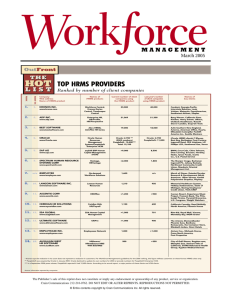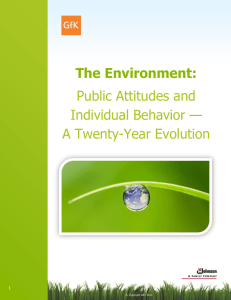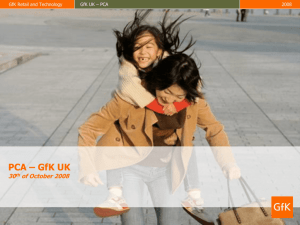Urban Presentation
advertisement
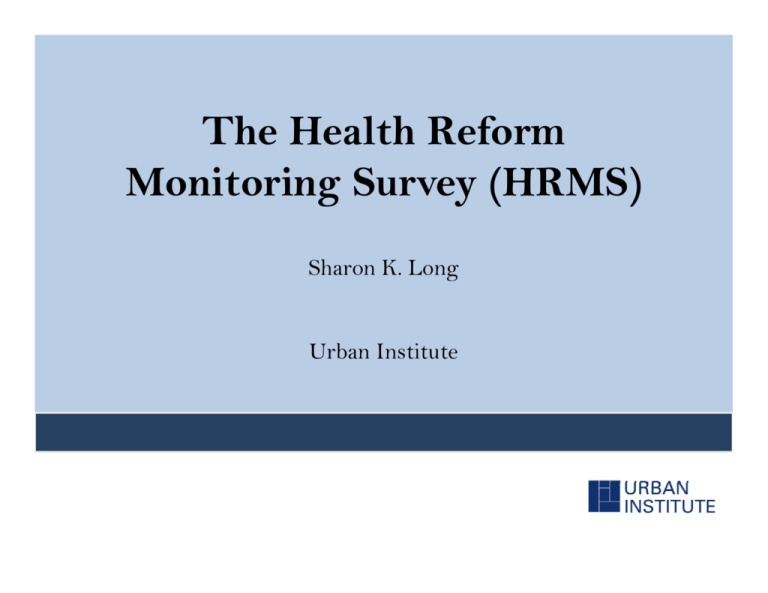
The Health Reform Monitoring Survey (HRMS) Sharon K. Long Urban Institute Objectives of the HRMS Obj S • Rapid-cycle monitoring of changes in coverage and health care access and affordability under the Affordable Care Act (ACA) – Data for 2014 in early 2014 2014, which is well before national survey data will be available • Timely information to support state ACA design and i l implementation t ti ttasks, k including i l di outreach, t h education, d ti and d enrollment processes – Data to support implementation in 2013 • Rapid-cycle feedback on early implementation experiences with the Medicaid expansion and the health insurance exchanges g across the states to support pp policy p y refinement – Data on early implementation experiences within 3-4 months 2 Overview of the HRMS O S • Quarterly internet-based survey of a nationally-representative sample of nonelderly-adults age 18 to 64 – Baseline survey began in Quarter 1 of 2013 – Plan Pl for f quarterly t l d data t collection ll ti in i 2013 and d 2014 • Findings from each survey reported in the following quarter – For example, information collected in June 2013 reported in July, August, and September 2013 – Will report on current circumstances and trends over time • Core q questions address coverage g and health care access and affordability every quarter • Supplemental questions added each quarter to address timely issues 3 Design g of the HRMS S • Based on GfK GfK’ss KnowledgePanel (formerly Knowledge Networks) – On-line survey research panel of 55,000 designed to be representative of the US population – Panel members drawn from probability-based sample of US households • Households who do not have Internet access are provided with laptop computers and internet service – Survey data available one week after survey completion – More information at: www.knowledgenetworks.com/ganp/index.html – Not a replacement for national surveys, but an important supplement that can support rapid-cycle monitoring • HRMS sample drawn from GfK’s KnowledgePanel – Stratified random sample of non-elderly non elderly adults 18 to 64 in the panel – Will support estimates for the nation, state subgroups and some large states, and income subgroups 4 Content of HRMS: Core Survey • Insurance coverage: – Coverage at the time of the survey and over the past year; Satisfaction with current insurance coverage on various dimensions • Access to and use of care: – Usual source of care; How long since routine checkup; Provider access problems; Unmet need for care (by type) • Affordability of care: – Problems paying medical bills; Amount of annual deductible under current insurance;; Amount of out-of-pocket p health care spending • Health status: – Physical and mental health status; health health-related related quality of life 5 Content of HRMS: Supplemental Information Available for GfK GfK’ss KnowledgePanel Members • GfK g gathers information from panel p members on a regular g basis. Examples of information we will have for our sample members: – Demographic D hi and d socioeconomic i i characteristics: h t i ti A Age, sex, race/ethnicity, marital status, education achieved, household income, homeownership, etc. – Health status: Presence of a chronic condition, smoking status, excess care required by a health condition, BMI, exercise i h habits, bi alcohol l h l use – Geographic information: State of residence 6 Content of HRMS: Quarterly Topical Modules • Q Quarterlyy topical p modules to address timelyy issues – June 2013 topics: • Health insurance literacy • Insurance coverage decision-making decision making and trade-offs trade offs • Sources of information used in health plan decisions • Attitudes toward insurance coverage – Future topics likely to address: • Health insurance exchange • Medicaid expansion p • Provider availability and access • Coverage availability in small firms • Health plan choice • Health care delivery issues and care management 7 Dissemination Plans • Benchmark HRMS data to national surveys y to document reliability of the HRMS (July 2013) • Short, targeted policy briefs on key issues – R Released l d within ithi 11-3 3 months th off survey fielding fi ldi – Current goal is to obtain funding to support at least one policy brief per month • Detailed D t il d tables t bl and d ffactt sheets h t – Quarterly summaries of trends over time for the nation and key subgroups (e.g., by income and state subgroups) • Potential to expand to include reporting for individual states states, where sample size would support such estimates • Public use file (PUF) – Some data will be suppressed to maintain the confidentiality of the sample and panel 8 Opportunities for Additional Investments Related to the HRMS - I • Provide funds to support pp the preparation p p of additional policy briefs based on HRMS data (Cost estimate: ~$100K and up) – Goall is to release l at lleast one policy l bbrieff per month h • Provide funds to support expanded survey questions and analysis for key issues or population subgroups (Cost estimate: ~$100K and up) – For example, support more in-depth questions to better understand the characteristics and circumstances of the remaining uninsured adults or support research into how to ask about health insurance exchanges 9 Example: Support for Expanded Survey Questions • Added a Child Supplement pp in Q Quarter 2,, 2013 – With support from new funders, were able to add additional questions to the core survey that focus on children – Respondent of adult survey in a household with children asked to answer questions about a random child in his/her household – Questions Q are similar to the core q questions for adults but designed g to reflect particular health care needs and services of children, including additional questions on Medicaid/CHIP eligibility and enrollment – Will prepare policy briefs and analyses focused on children – Funding includes support for core project activities 10 Opportunities for Additional Investments Related to the HRMS - II • Provide funds to expand the ability of the project to report on i di id l states individual – Expand the sample size for an individual state, including statespecific analyses and support for the core project (Cost estimate: ~$100K $100K to t $150K per year plus l survey costs) t) • Products: State data file and PUF for national data, memo that benchmarks state data to national surveys, and a quarterly monitoring memo that compares trends in the state to the region and the nation. There is also the potential for state-specific policy briefs. • Acknowledged as contributing funder to the core project – Expand the sample size for an individual state, with no state-specific analyses and no contribution toward the core project (Cost estimate: ~$32K to $100K per year in survey costs) • Products: P d S State d data file fil and d PUF ffor national i l data d 11 Example: Support Expanded State Samples • Three ppotential strategies g to expand p state sample p sizes, in order of preference 1. 2. Draw additional sample from GfK’s KnowledgePanel Draw additional sample p from GfK’s KnowledgePanel g and supplement with opt-in sample • The opt-in sample differs from the KnowledgePanel in that it is convenience sample rather than probability-based sample. GfK has d l d methods developed h d to combine bi K KnowledgePanel l d P l sample l and d opt-in i sample to take advantage of the stronger design of the KnowlegePanel. 3. Base the state sample largely on opt-in sample • The available l l option d depends d on the size of a given state and d therefore the amount of sample available on the KnowledgePanel 12 Example: Support Expanded State Samples • Projected state samples per quarter with current design: – Sample size >500: >500 CA (810), (810) IL (710), (710) NY(580) – Sample size ~250-500: TX(450), MI (410), VA (360), FL (310), OR (280), MN (270) – Remaining states will have sample sizes <250 • Potential for expanded p sample p pper q quarter based on KnowledgePanel g only: – – – – – ~1000 or more: CA (3300), FL (1500), NY (1200), OH (1000), TX (2000) ~750 to 1000: PA, IL, MI ~500-750: 500 750: NC, GA, WA, WI, MN, AZ, NJ, VA, MO, MA ~200-500: IA, TN, CO, OR, MD, IA, AL, KY, CT, SC, UT, OK, LA, KS, NV <200: NM, NE, AR, MS, ID, WV, ME, NH, SD, MT, RI, DE, ND, HI, DC, VT, AK, WY • Potential for expanded sample per quarter based on KnowledgePanel with opt-in opt in sample supplement: supplement Up to four times the KnowledgePanel sample size for states with at least 200 panel members • Largely opt-in sample for states with less than 200 panel members – However However, GfK can do custom recruitment to expand the KnowledgePanel in a state to support stronger data 13 Q Questions? • Urban Institute – John Holahan – Genevieve Kenney – Sharon Long • GfK (KnowledgePanel) – Jordon Peugh • Robert Wood Johnson Foundation – Andy Hyman – Kathy Hempstead 14 Contacts for Follow-Up C p Questions Q • General questions on the survey and methods? – Dana Goin, UI: dgoin@urban.org – We will compile a list of Frequently Asked Questions • Interested in a state-specific supplemental sample? – Kathy Hempstead, RWJF: khempstead@rwjf.org • IInterested t t d in i contributing t ib ti toward t d the th broader b d study t d ((with ith or without a state-specific supplemental sample)? – Sharon Long, UI: slong@urban.org • Interested in the child supplement? – Genevieve Kenney, UI: jkenney@urban.org • Interested I t t d in i GfK’s GfK’ KnowledgePanel? K l d P l? – Jordon Peugh, GfK: jordon.peugh@gfk.com 15

